|
|
|
|||
|
|
||||
|
|
||||
| Smoke Trails | ||||
|
|
HOME | SITE MAP | FORUM | CONTACT |
|
||
|
ABOUT | MOTORS | MODELS | ARCHIVE | HISTORY | STORE | FAQ | LINKS
|
|
|
|
|
|
||||||||||||||||||||||||||||||||||||||||||||||||||||||||||||||||||||||||||||||||||||||||||||||||||||||||||||
|
Smoke Trails 1
(February 2006)
by Roger Simmonds Reprinted from SAM 35 Speaks, February 2006 I don’t know why it is, but, over the years, the SAM 35 Speaks ‘Jetex’ column has been subjected to more changes of name than the Supermarine Swift was to major modifications of concept and design. Since 1989, we have had, apart from my own efforts, Frank Gardiner’s ‘Jetstream’, John Emmet’s ‘Jetex Matters’ and ‘Jetex Natters’, and Terry Kidd’s ‘Jet Reaction’. So finding a new and apposite title has exercised what is left of my little grey cells – after all those years of inhaling rocket exhaust – to their limits. Having considered Reactionary Ruminations, Pyrotechnic Pensées, or even Jetstream II, I alighted on Smoke Trails, which has, I think, a somewhat ‘vintage’ flavour. I hope it meets with Funf’s approbation. For this first article, though, Henri Coanda’s ‘Aéroplanes sans hélices’ would be appropriate! |
|
||||||||||||||||||||||||||||||||||||||||||||||||||||||||||||||||||||||||||||||||||||||||||||||||||||||||||||

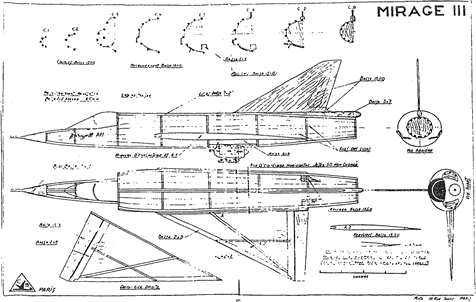 |
|
 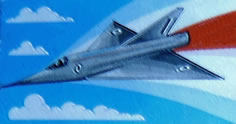 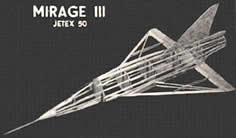
- Roger Simmonds
|
|||||||||||||||||||||||||||||||||||||||||||||||||||||||||||||||||||||||||||||||||||||||||||||||||||||||||||
|
|
|
||||
|
Even in a pristine state, this may not have been very inspiring. The box art (right), too, gives very little confidence that this is an accurate rendition of the subject; it is, like Sigurd Isacson’s Draken (a similar design in some ways) probably no more than ‘stand well off’ scale. |
|||||
|
The Mirage III is of course no different from many other kits (or plans) of the fifties that were, for a variety of reasons, not very accurate. The Veron and Keil Kraft F-86 Sabres (right) for example, where Phil Smith and Albert Hatfull made many deviations from scale in the hope of enhancing their product’s flying characteristics: enlarging the tailplane (probably necessary); increasing the fin and dihedral (probably not necessary); reducing sweepback (definitely unnecessary!). If you think I’m just being contentious here, remember that Pete Smart’s accurate Sabre (below right) will fly beautifully with the right motor. There is, alas, no plan (yet!) for this diminutive model. In defence of Messrs Hatfull and Smith, probably neither had access to good 3-views to start with, and, adding to a kit designer’s frustrations, many of the full-size prototypes of the fifties altered radically during development anyway (the Convair F-102 and aforementioned Swift are obvious examples). The accumulated inaccuracies of the final product might have posed a problem for the manufacturers, except that it doesn’t seem to have bothered them overmuch! But it certainly does bother, and poses a conundrum for, the meticulous vintage modeller – does one build that Easy Built Swift or Keil Kraft Sabre ‘as is’, or modify it in the light of fifty years of jet modelling and all the extra scale data we now have to hand? As with the other great philosophical questions of our time, there can be no definitive answer. Howard Metcalfe modified both the Keil Kraft Hunter and Easy Built Swift (below right) to his own satisfaction, adding stringers and extending the air intakes of the latter to arrive at an acceptable simulacrum of Mike Lithgow’s all-blue record breaker. Andy Blackwell, however built his KK P.1067 for vintage Jetex 50 strictly according to Albert Hatfull’s plan. Marty Richey is an experienced and meticulous modeller who lives in the US. Putting aside an Easy Built Swift in some despair, he turned to the Keil Kraft Sabre (below right). It will be appreciated that this is by no means the model as designed by Albert Hatfull. Marty writes: “This F-86 is based on the rather unflattering Keil Kraft kit, with a laminated leading edge and 1/16" spruce spars. The airfoil was changed to flat bottom and the T/C ratio reduced. It weighs 15.9 grams with the distinctive tail group complete. The fin is scale; the horizontal stab is roughly 20% over scale [i.e. reduced from the KK kit] with scale dihedral. Wing dihedral was increased over scale but only slightly. There are many classic Jetex plans, but like this KK Sabre, they are often far from scale. However, if you overlay the plan over an accurate three view you can fix most of the problems. The side view build ‘plan’ consists of KK plan scaled down to 13" wingspan overlaid a scaled up ‘Squadron/Signal’ 3-view. The areas of changes are shown with coloured markers. As Mike Stuart found with his [Skyleada] F-100 Super Sabre, the noses of kit designs were often modified. “This can be fixed by measuring the differences observed and redrawing on the formers affected to correct them. [As the] nose and tail group differentiate one plane from another, fixing these will give the finished model the scale cues needed most. Most jets have curved outlines, so I like to build the outlines with two water soaked 1/16" soft balsa laminated stringers and use a covering iron to pre-shape the other stringers so no stress is applied to the half fuselage. Slot misalignment is checked and corrected before each is applied.” Marty has made a wonderful job of (let’s be frank) one of Albert Hatfull’s less inspired creations. As Sabres are not common on the flying field, I hope that those who have, like me, a KK Sabre languishing in the loft, will be motivated to follow Marty’s example. As to the Mirage III, it’s a real pity the box’s beauty was only skin deep and it contained little or nothing relating to the original kit! All is not lost, though: there is a good chance Steve Bage will exercise his consummate CAD skills to restore the much degraded plan from the reduced photocopy, using the Jetex 50 to scale it up. I hope he will resist the temptation to make too many amendments. For myself, I would put the motor in a trough and add some sheeting and an extra wing rib or two, but, following the example of Chris Strachan with his Isacson Draken, I would not correct the scale anomalies. If any reader knows anything more about this model – when it was produced, who the designer was, or has a better (and preferably full-size) copy of the plan – please let me know. |
 Keil Kraft F-86 Sabre
- Aeromodeller, Jan. 1952 (back cover)
 Peter Smart’s small but perfectly formed Sabre
- Peter Smart
 Howard Metcalfe’s modified Easy Built Swift
- Howard Metcalfe
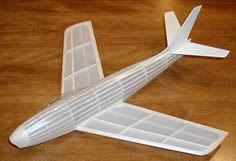 
- Marty Richey
|
||||
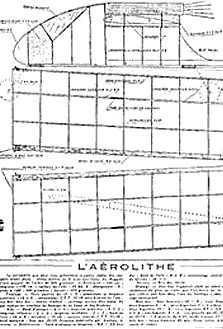
December’s article referred to several early post-war French models: the Bizuth, Tapir, Aérolithe and Soucoupe. Jean Thiry has now kindly provided us with plans for all of these. The Tapir and Bizuth were pure sailplanes. The Aérolithe (right) was very similar, but powered by a Ruggieri rocket, and its wingspan (1.4 metres, about 56"), bears out Georges Bougueret’s claim that the Ruggieri rockets were suitable for models “of Wakefield size”. The twin fins may cause some ‘tucking in of the turn’ under power, but this caveat apart, it is a most stylish and practicable model. A reduction of at least 50% is required for Rapier L-2 power. |
|
 The French rocket propelled Aérolithe
- Le Modèle Réduit d'Avion, 1946
|
|||
The Soucoupe (‘saucer’) is comparable to Bill Dean’s Space Scooter and Skycraft Models’ Flying Saucer (see below). The latter was discussed in ‘Jetex Matters’ in SAM 35 Speaks, June 1987, where John Emmet comments that Jetex were also quick to exploit the ‘UFO craze’, producing their own 50 powered flying saucer in 1950 (i.e. well before Peter Cock’s VTO experiments). Does anyone know anything about this particular UFO? |
|
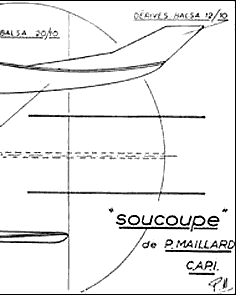 Maillard’s Soucoupe for Jetex 50
- Le Modèle Réduit d'Avion, 1951
|
|||
|
|||||
|
|
|||||
|
|
|
||||
|
|
|
|
|
|
|
|
Acknowledgements - Article: Roger Simmonds - Illustrations: Roger Simmonds, Bill Henderson, Howard Metcalfe, John Park, Jean Thiry, Peter Tolhurst |
|
|
|
|
ABOUT | MOTORS | MODELS | ARCHIVE | HISTORY | STORE | FAQ | LINKS |
|
|
Terms of Use
|
Queries? Corrections? Additions?
Please
contact us.
|
|